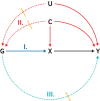Strengthening the reporting of observational studies in epidemiology using mendelian randomisation (STROBE-MR): explanation and elaboration
- PMID: 34702754
- PMCID: PMC8546498
- DOI: 10.1136/bmj.n2233
Strengthening the reporting of observational studies in epidemiology using mendelian randomisation (STROBE-MR): explanation and elaboration
Abstract
Mendelian randomisation (MR) studies allow a better understanding of the causal effects of modifiable exposures on health outcomes, but the published evidence is often hampered by inadequate reporting. Reporting guidelines help authors effectively communicate all critical information about what was done and what was found. STROBE-MR (strengthening the reporting of observational studies in epidemiology using mendelian randomisation) assists authors in reporting their MR research clearly and transparently. Adopting STROBE-MR should help readers, reviewers, and journal editors evaluate the quality of published MR studies. This article explains the 20 items of the STROBE-MR checklist, along with their meaning and rationale, using terms defined in a glossary. Examples of transparent reporting are used for each item to illustrate best practices.
Conflict of interest statement
Competing interests: All authors have completed the ICMJE uniform disclosure form at www.icmje.org/disclosure-of-interest/ and declare: support from the SNSF, NIHR Biomedical Research Centre at University Hospitals Bristol, Weston NHS Foundation Trust, and University of Bristol for the submitted work; no financial relationships with any organisations that might have an interest in the submitted work in the previous three years; EWL (head of research at The BMJ) played no part in the peer review or decision making of this paper at the editorial level, and contributed solely as an author; no other relationships or activities that could appear to have influenced the submitted work. Provenance and peer review: Not commissioned; externally peer reviewed
Figures




Similar articles
-
Strengthening the Reporting of Observational Studies in Epidemiology Using Mendelian Randomization: The STROBE-MR Statement.JAMA. 2021 Oct 26;326(16):1614-1621. doi: 10.1001/jama.2021.18236. JAMA. 2021. PMID: 34698778 Review.
-
Strengthening the Reporting of Observational Studies in Epidemiology-Nutritional Epidemiology (STROBE-nut): An Extension of the STROBE Statement.PLoS Med. 2016 Jun 7;13(6):e1002036. doi: 10.1371/journal.pmed.1002036. eCollection 2016 Jun. PLoS Med. 2016. PMID: 27270749 Free PMC article.
-
[How to write high-quality epidemiological research paper Ⅵ. Strengthening the Reporting of Observational Studies in Epidemiology-Nutritional Epidemiology (STROBE-nut)].Zhonghua Liu Xing Bing Xue Za Zhi. 2017 Jan 10;38(1):121-127. doi: 10.3760/cma.j.issn.0254-6450.2017.01.023. Zhonghua Liu Xing Bing Xue Za Zhi. 2017. PMID: 28100390 Chinese.
-
Explanation and Elaboration Document for the STROBE-Vet Statement: Strengthening the Reporting of Observational Studies in Epidemiology - Veterinary Extension.Zoonoses Public Health. 2016 Dec;63(8):662-698. doi: 10.1111/zph.12315. Epub 2016 Nov 22. Zoonoses Public Health. 2016. PMID: 27873473
-
Strengthening the Reporting of Observational Studies in Epidemiology for respondent-driven sampling studies: "STROBE-RDS" statement.J Clin Epidemiol. 2015 Dec;68(12):1463-71. doi: 10.1016/j.jclinepi.2015.04.002. Epub 2015 May 1. J Clin Epidemiol. 2015. PMID: 26112433 Free PMC article. Review.
Cited by
-
Genetic Evidence for the Causal Relationship Between Gut Microbiota and Diabetic Kidney Disease: A Bidirectional, Two-Sample Mendelian Randomisation Study.J Diabetes Res. 2024 Oct 23;2024:4545595. doi: 10.1155/2024/4545595. eCollection 2024. J Diabetes Res. 2024. PMID: 39479291 Free PMC article.
-
Appraising the Role of Circulating Concentrations of Micronutrients in Hypertension: A Two-sample, Multivariable Mendelian Randomization Study.Glob Heart. 2024 Oct 29;19(1):81. doi: 10.5334/gh.1367. eCollection 2024. Glob Heart. 2024. PMID: 39479260 Free PMC article.
-
Investigating the causal association between serum uric acid levels and gastric cancer risk: a Mendelian randomization study.Sci Rep. 2024 Oct 30;14(1):26165. doi: 10.1038/s41598-024-77788-7. Sci Rep. 2024. PMID: 39478158 Free PMC article.
-
Breast cancer and neoplasms of the thyroid gland: a bidirectional two-sample Mendelian randomization study.Front Oncol. 2024 Oct 14;14:1422009. doi: 10.3389/fonc.2024.1422009. eCollection 2024. Front Oncol. 2024. PMID: 39469634 Free PMC article.
-
Breakfast skipping is linked to a higher risk of major depressive disorder and the role of gut microbes: a mendelian randomization study.Nutr J. 2024 Oct 28;23(1):133. doi: 10.1186/s12937-024-01038-9. Nutr J. 2024. PMID: 39468606 Free PMC article.
References
Publication types
MeSH terms
Grants and funding
- MC_UU_00006/1/MRC_/Medical Research Council/United Kingdom
- MC_UU_00011/5/MRC_/Medical Research Council/United Kingdom
- MR/M005070/1/MRC_/Medical Research Council/United Kingdom
- R01 CA222147/CA/NCI NIH HHS/United States
- 29019/CRUK_/Cancer Research UK/United Kingdom
- MC_UU_00011/2/MRC_/Medical Research Council/United Kingdom
- 19169/CRUK_/Cancer Research UK/United Kingdom
- MC_UU_00011/7/MRC_/Medical Research Council/United Kingdom
- 001/WHO_/World Health Organization/International
- MC_UU_00011/1/MRC_/Medical Research Council/United Kingdom
- MC_UU_00011/6/MRC_/Medical Research Council/United Kingdom
